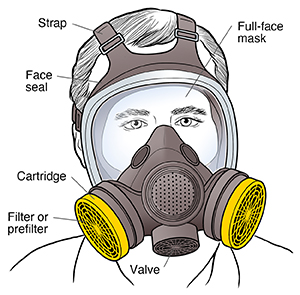Understanding Respirators
To get the best protection from a respirator, you need to learn about its different parts. When used, maintained, and replaced the right way, the parts of a respirator can lessen your exposure to nearby hazards.

-
Straps hold the mask snugly in place.
-
A face seal keeps contaminants out of the mask.
-
A cartridge captures certain gases and vapors.
-
A filter or prefilter traps particles.
-
A full-face mask adds eye protection.
-
A valve opens when you exhale and closes when you inhale.
Filtering out the hazards
Cartridges trap gases and vapors. Filters trap particles. All cartridges, filters, and prefilters must be certified by NIOSH (National Institute for Occupational Safety and Health). NIOSH rates filters on a scale of 3 efficiency levels. These are 95%, 99%, and 99.97%. Within these efficiency levels are 3 filter types. These are N, R, and P. This classification refers to how effective a filter works when exposed to oils:
-
N filters. These are used when there are no oily particles.
-
R filters. These can be used to protect against oily particles. They are somewhat resistant to oils.
-
P filters. These provide the highest level of safety against all particles. They are strongly resistant to oils.
When to replace filters and cartridges
Follow instructions from your supervisor or the respirator manufacturer to learn when to replace your prefilter, filter, or cartridge.
© 2000-2024 The StayWell Company, LLC. All rights reserved. This information is not intended as a substitute for professional medical care. Always follow your healthcare professional's instructions.